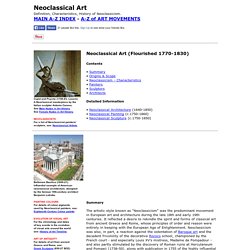

RESTORATION AND THE AGE OF ENLIGHTENMENT (1660-1798) Historical Background:- ENGLISH CIVIL WARS (1641-1645, 1648-1649) between the King (Charles I and Charles II, Stuart Kings who overestimated the power of the Monarchy) and the Parliament (led by Oliver Cromwell), a confrontation which also had economic and religious overtones (Puritans against the Church of England, urban traders against rural land-owners).- After a protectorate, the Monarchy was restored with James II in 1660 (“the Restoration”).
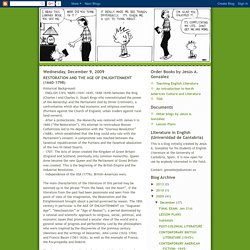
His attempt to reintroduce Roman Catholicism led to his deposition with the “Glorious Revolution” (1688), which established that the king could only rule with the Parliament’s consent. Themes of the English Restoration Poetry. How did the ideas of the Enlightenment influence the arts? The Enlightenment called on humankind to attempt to understand its place in the natural world based on scientific reason instead of religious belief.

One way the arts displayed this was in the naturalistic novels that began to appear in the 17th and 18th centuries. The foremost example is "Robinson Crusoe" by Daniel Defoe, which many scholars consider the first modern English novel. The Restoration Period in English Literature: Timeline & Overview. This lesson will explore what is known as the Restoration era of English literature, which lasted from 1660 to about 1688.
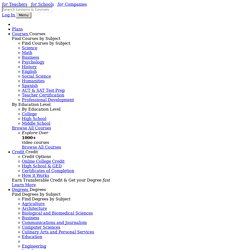
We'll look at the context, themes, and styles that define this period of literature. Explore our library of over 10,000 lessons Click "next lesson" whenever you finish a lesson and quiz. Got It You now have full access to our lessons and courses. You're 25% of the way through this course! John Dryden. 17th-century English poet and playwright John Dryden (; 19 August [O.S. 9 August] 1631 – 12 May [O.S. 1 May] 1700) was an English poet, literary critic, translator, and playwright who was made England's first Poet Laureate in 1668.[1] Early life[edit] Dryden was born in the village rectory of Aldwincle near Thrapston in Northamptonshire, where his maternal grandfather was rector of All Saints.
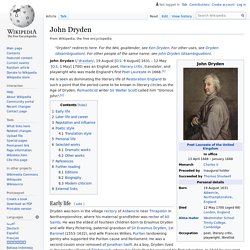
He was the eldest of fourteen children born to Erasmus Dryden and wife Mary Pickering, paternal grandson of Sir Erasmus Dryden, 1st Baronet (1553–1632), and wife Frances Wilkes, Puritan landowning gentry who supported the Puritan cause and Parliament. He was a second cousin once removed of Jonathan Swift. As a humanist public school, Westminster maintained a curriculum which trained pupils in the art of rhetoric and the presentation of arguments for both sides of a given issue. Later life and career[edit] Dryden, by James Maubert, c. 1695 Frontispiece and title page, vol. John Dryden in Restoration Literature. The Origins of Modernism in Russian Architecture.
Art 101: What is Neoclassicism? Next post in the “Art 101” series: Neo-Classicism.
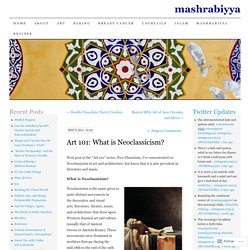
I’ve concentrated on Neoclassicism in art and architecture, but know that it is also prevalent in literature and music. What is Neoclassicism? Neoclassical Art, Neoclassicism (1770-1830) Origins & Scope The revival of artistic canons from Classical Antiquity was not an overnight event.
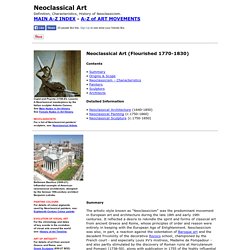
It built on Renaissance art itself, as well as the more sober styles of Baroque architecture, the mood of Enlightenment, the dissatisfaction with the Rococo, and a new respect for the earlier classical history painting of Nicolas Poussin (1593-1665), as well as the classical settings of Claude Lorrain's (1600-82) landscapes. Furthermore, it matured in different countries at different times. Neoclassical architecture actually originated around 1640, and continues to this day. Neoclassical Literature: Definition, Characteristics & Movement. Neoclassical literature was written between 1660 and 1798.
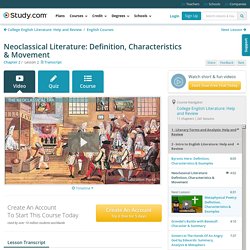
It was a time of both formality and artificiality. In this lesson, we will examine the characteristics and literature of this time period. Explore our library of over 10,000 lessons Click "next lesson" whenever you finish a lesson and quiz. Got It You now have full access to our lessons and courses. The Origins of Modernism in Russian Architecture. Literature in English (UNICAN): RESTORATION AND THE AGE OF ENLIGHTENMENT (1660-1798) Themes of the English Restoration Poetry. Neoclassicism, an introduction. Nicolas Poussin, Et in Arcadia Ego, 1637-38, oil on canvas, 185 cm × 121 cm (72.8 in × 47.6 in) (Louvre) In opposition to the frivolous sensuality of Rococo painters like Jean-Honoré Fragonard and François Boucher, the Neoclassicists looked back to the French painter Nicolas Poussin for their inspiration (Poussin's work exemplifies the interest in classicism in French art of the 17th century ).

The decision to promote "Poussiniste" painting became an ethical consideration—they believed that strong drawing was rational, therefore morally better. They believed that art should be cerebral, not sensual. The Neoclassicists, such as Jacques-Louis David (pronounced Da-VEED), preferred the well-delineated form—clear drawing and modeling (shading). Drawing was considered more important than painting.
France was on the brink of its first revolution in 1789, and the Neoclassicists wanted to express a rationality and seriousness that was fitting for their times. Essay by Dr. Additional resources: Neoclassical Art, Neoclassicism (1770-1830) Origins & Scope The revival of artistic canons from Classical Antiquity was not an overnight event.
